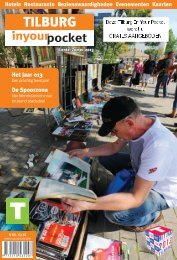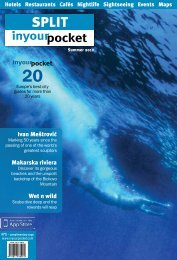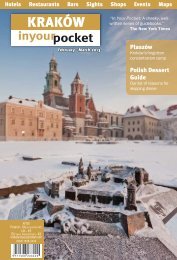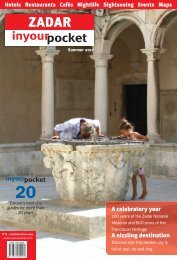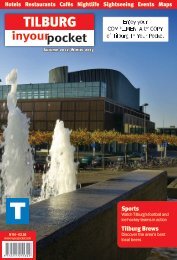7kh 7ul flw\ v prvw dxwkhqwlf 7h[ 0h[ uhvwdxudqw ... - In Your Pocket
7kh 7ul flw\ v prvw dxwkhqwlf 7h[ 0h[ uhvwdxudqw ... - In Your Pocket
7kh 7ul flw\ v prvw dxwkhqwlf 7h[ 0h[ uhvwdxudqw ... - In Your Pocket
Create successful ePaper yourself
Turn your PDF publications into a flip-book with our unique Google optimized e-Paper software.
76<br />
WORLD WAR II<br />
What to See<br />
Bunkers. Several Nazi era bunkers, shelters and fortifications<br />
can still be found, and while the forests of Gdynia<br />
are particularly abundant with such concrete carbuncles<br />
one doesn’t haven’t to stray anywhere near that far. <strong>In</strong><br />
central Gdańsk, for instance, head to C-3, Olejarna 2 to<br />
find a hulking big air raid shelter dating from 1943. Used<br />
as a climbing wall in recent years, its entrance is currently<br />
bolted closed.<br />
<strong>In</strong> close proximity why not visit the U7 bowling alley (C-3 Plac<br />
Dominikański 7) . There’s a particularly sordid story behind<br />
this one; after the war German prisoners seconded into<br />
rubble clearance noticed a horrific stench emanating from the<br />
ground. When they broke through the entrances, which had<br />
collapsed under bombardment, they found it literally flooded<br />
with gunk. The air raid shelter, built below the water table,<br />
had flooded during shelling, and those trapped inside had<br />
been slowly drowned in the most agonizing way imaginable.<br />
The putrid soup in front of them was decomposing remains<br />
mixed with stagnant flood water.<br />
Elsewhere, check out the Napoleonic hilltop forts on Gdańsk’s<br />
Grodzisko Hill (A-1/2, ul. Gradowa). Built 46 metres above<br />
sea level the views across the Gdańsk are awesome, and<br />
their strategic importance wasn’t lost on the Germans. Close<br />
up investigation is obstructed by fences and warning signs,<br />
though you can just about make up a concrete observation<br />
post installed at some stage during the war.<br />
Dr. Spanner. Operating from a small outhouse in the<br />
courtyard of the (H-3) Gdańsk Medical Academy (ul. Marii<br />
Skłodowskiej - Curie 3a) Dr Rudolf Spanner perpetrated<br />
what is commonly regarded as one of the most heinous<br />
crimes of WWII. It was here that he produced soap using<br />
the fat of prisoners from the nearby Stutthof death camp.<br />
When Gdańsk was liberated in 1945 over 400 bodies were<br />
discovered in the buildings’ basement, their use only too<br />
apparent. Spanner was not prosecuted, and though details<br />
of his life are foggy, he was apparently allowed to continue<br />
with a career in medicine in the following years. Today the<br />
set of buildings where he conducted his grisly research have<br />
been renovated, with a plaque outside reading:<br />
‘<strong>In</strong> this building, during World War II, the Nazis used the<br />
bodies of victims of genocide. People executed in the<br />
prisons of Konigsberg and Gdansk, the patients of the<br />
regional home for the mentally impaired in Kocborowo,<br />
and the inmates of the concentration camp in Stutthof<br />
as material to produce soap. People brought this fate<br />
upon people.’<br />
Forsterówka ul. Lazurowa 4 (Sobieszewo), www.<br />
wyspa.pl. If you’ve got your own transport take a trip out to<br />
the Sobieszewo Island, and the out-of-town residence used<br />
by Albert Forster - the Nazi governor of Gdańsk from 1939 till<br />
1945. His lodge has remained fenced off from the public for<br />
years although we now understand it is the property of the<br />
Franciscan Brothers who plan to create a religious complex<br />
here in the next couple of years with a small display dedicated<br />
to Forster. The forests surrounding the complex were<br />
frequently used as a hunting ground for Forster, apparently<br />
a man of extravagant tastes. It was in this private domain<br />
where he entertained the captain of the Schleswig-Holstein<br />
in 1939. If you get close enough to his villa you’ll find traces<br />
of intricate Nazi-era workmanship on the timber roof. Forster<br />
had an underground bunker added for his benefit, complete<br />
with air-conditioning and electricity, and it was here that<br />
conquering Red Army troops found a hoard of stolen Nazi<br />
loot. The surrounding buildings were used as an SS barracks,<br />
and a military hospital was also added in 1941.<br />
Polish <strong>In</strong>ternal Security formerly home to Danzig Gestapo<br />
Gestapo HQ B-5, ul. Okopowa 9. What’s that sinister<br />
looking building on Okopowa 9? It’s currently occupied by<br />
the <strong>In</strong>ternal Security Services, though it’s history is far more<br />
creepy. It’s here the Gestapo had their Danzig HQ, and above<br />
the main entrance it’s still possible to make out lettering<br />
feebly disguised with paint: ‘Polizei Prasidium’.<br />
Military Cemetery I-3, ul. Dąbrowskiego 2, tel. (+48)<br />
609 69 07 39. WWII saw heavy casualties on all sides, none<br />
heavier than in the last year of the war when the city faced the<br />
wrath of Allied bombing and the advancing Red Army. Such<br />
was the destruction and the size of the area covered by the<br />
conflict, that bodies of soldiers and civilians continue to be<br />
found right up until today. Those identified as German combatants<br />
are repatriated or re-buried in the Military Cemetery<br />
which can be found at the rear of the civilian cemetery on ul.<br />
3-Maja. While the Red Army cemetery is clearly marked and<br />
separated by a fence the Germany Military Cemetery can<br />
be reached by walking through and up the civilian graveyard<br />
to where you will find a series of monuments and the odd<br />
German flag. Not just containing the remains of casualties<br />
of WWII, you’ll also see stones marking the German dead of<br />
WWI and the Franco-German war of 1870. There is a stone<br />
letter box of sorts for people to leave prayers or mass cards.<br />
Q Open from dawn till dusk.<br />
Nowy Port Lighthouse ul. Przemysłowa 6a (Nowy<br />
Port), tel. (+48) 601 15 02 51, www.latarnia.gda.pl.<br />
A fascinating delve into Gdańsk‘s maritime history, the<br />
city‘s Nowy Port Lighthouse was inspired by a long-lost<br />
lighthouse built in 1871 in Cleveland, Ohio, in the USA.<br />
This one in front of you was built in 1893, the 28-metre<br />
tower functioned as a lighthouse, harbour pilot’s tower<br />
and time-ball station until it was finally decommissioned<br />
in 1984. Its principal claim to fame is its use by German<br />
soldiers in September 1939, and it was from the upper<br />
floors that a machine gun emplacement fired the very<br />
first shots of WWII. The machine gun nest was destroyed<br />
in the exchange that followed, quite possibly making the<br />
Germans manning it the first casualties of a war which<br />
would claim over seventy million lives. Painstakingly<br />
restored by an amiable Polish-Canuck the centrepiece of<br />
the lighthouse is a time ball, unveiled on May 21, 2008.<br />
During its former life it was synchronised to the Royal<br />
Astronomical Observatory in Berlin but today it takes its<br />
signal from Physikalisch-Technische Bundesanstalt (PTB)<br />
in Braunschweig which is broadcast as a DCF77 long-wave<br />
radio signal by the European Time Centre in Mainflingen,<br />
Germany. Time-balls were originally designed to allow<br />
ships’ captains out at sea to sychronise their on-board<br />
clocks exactly before they headed back out, the dropping<br />
of the ball being the signal to mark the hour - this would<br />
allow them to calculate longitude resulting in more accurate<br />
navigation. Weirdly, scandalously even, ferries have<br />
stopped hooking up by here, meaning you’ll have to either<br />
Gdańsk <strong>In</strong> <strong>Your</strong> <strong>Pocket</strong> gdansk.inyourpocket.com<br />
locate it on the map or jump on the number 10 tram from<br />
Dworzec Główny and get off at Nowy Port (note that there<br />
is a temporary bus service running for the last part of the<br />
journey). Q Open May 1-6 every day 10:00 - 18:00. May<br />
7-31 Sat-Sun only 10:00-18:00. From June open every day<br />
10:00 - 18:00. Admission 8/5zł, family ticket 16zł. Y<br />
Post Office Monument (Pomnik Poczty Polskiej)<br />
D-2, ul. Obrońców Poczty Polskiej. Commissioned in 1979<br />
by the Polish Communications Ministry and the Council for<br />
the Protection of Monuments of Battle and Martyrdom, and<br />
unveiled on September 1 of the same year, the stainless<br />
steel Defenders of the Polish Post Monument was designed<br />
by the Kraków-based sculptor Wincenty Kućma. A wonderful<br />
example of Communist-era public art and a fitting tribute to<br />
the heroes who put up such a brave struggle across the road,<br />
the monument represents a dying Polish post employee who<br />
is being handed a rifle, unfortunately a little too late, by Nike.<br />
gdansk.inyourpocket.com<br />
The Soviet Cemetery on 3-go Maja<br />
WORLD WAR II<br />
Soviet Cemetary I-3, ul. 3 Maja. Some 3,089 Soviet<br />
soldiers who fell during the siege of Danzig are buried in<br />
the cemetery on A-1, ul. 3-go Maja. The Soviets aren’t remembered<br />
fondly by either Poles or Germans, so to find the<br />
graveyard in disarray comes as little surprise.<br />
SS street I-4, ul. Ojcowska. Search out ul. Ojcowska to<br />
find a street custom built for the SS. Amazingly, as a look on<br />
GoogleMaps reveals, seen from the air the two rows of terraced<br />
housing which flank the street gently curve in the style<br />
of the SS moniker. Ojcowska survived the war, with the communist<br />
state opting to house shipyard workers in the buildings.<br />
The Tank (Czołg) H-3, Al. Zwycięstwa. As you head<br />
up Victory Avenue (Al. Zwycięstwa) towards Wrzeszcz from<br />
Gdańsk old town, you may notice a small green tank sitting<br />
on a plinthe to your right. This Russian made T-34 celebrates<br />
the ‘liberation’ of Gdańsk in May 1945. According to local<br />
information, this is tank #121 which was under the command<br />
of Lieutenant Julian Miazga and was the first to enter<br />
Gdynia on March 27th 1945 as part of the Soviet/Polish<br />
offensive on the city.<br />
However alternative reports claim that Miazga’s tank was<br />
destroyed in Redłowo just outside of Gdynia and the tank<br />
you see before you was in fact one of the other tanks which<br />
survived the battle and not the symbolic 121 belonging to<br />
Miazga. <strong>In</strong> a further twist, a local group protested in 2000,<br />
on the 55th anniversary of the liberation, that the tank was<br />
inappropriate and tabled a petition questioning the legitimacy<br />
of honouring an event which to them represented the passing<br />
of the city from one occupier to another. The petition appears<br />
to have fallen on deaf ears, particularly from the local government,<br />
and the tank still stands today. Regular paint jobs<br />
are required to cover up the frequent graffiti that it attracts.<br />
May - July 2012<br />
77




